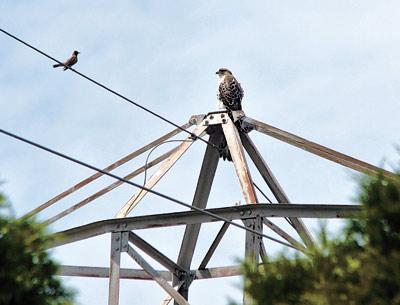Nature Notes: An Exquisite Surprise

There are a lot of things I would like to see for the first time before I give up the ghost. I have a list of them — five pages long — that I keep adding to. On occasion Saint Serendipity takes me to one not on my list.
Such was the case last Friday when I ended up with four botanists at the Shinnecock Indian Reservation south of Hill Street in Southampton. We were to work with a trio of Shinnecock women interested in the reservation’s flora. Two of us, Vicki Bustamante and I, who didn’t know quite where we were all going to meet, ended up at the Shinnecock Nation Cultural Center and Museum sequestered between seven or eight smoke shops at the edge of the highway.
Quite a stroke of good luck. I’ve been to a lot of museums, including some Amerindian ones in my 78 years, not all of which were situated in the United States. If I wrote them all down it would take several pages, so I won’t. We have several right here on the South Fork. However, the one that Vicki and I happened to bump into by chance was one of the top five in my eyes, an exquisite collection of Indian artifacts, taxidermied animals, wampum shells, dioramic paintings, costumes, and other items that, to be truthful, boggled my mind. Here it was, right under my nose since 2001, and I didn’t know it existed.
We were in luck that day, as Elizabeth Haile, one of the museum’s board members, and member with me of the board of the Peconic Sustainability Institute, happened to be on hand to show us around. The museum’s curator and originator, David Martine, was not in, but Elizabeth did a fine job. Doesn’t it cost more than $10 to attend a movie at a local movie house where you might spend a little more than an hour watching car chases and gunfights? It costs a measly $5, one Abe as it were, to spend hours and hours here finding out what our bona fide natives and their culture was, is, and will be like.
The building is log cabin-like and built in the tradition of early American buildings and ships, timbers put together with dowels. It was first constructed by Native Americans on a reservation in upstate New York, Oneonta, it seems, from local white pine, shaved of bark and fitted together with pegs. Then, it was deconstructed by knocking out the pegs, packaged, shipped to its present site, then resurrected with the same care to detail, structural engineering, and aesthetics.
Eleven years later it is a precursor to a model Shinnecock village, complete with wickiups, palisade fences, tribal council and meeting house, gardens and lots more, which are to begin construction soon behind the museum. Ironically, perhaps, the Shinnecock village will rise at the same time that the Stony Brook Southampton site nearby — which as Southampton College was an integral part of the Long Island University system for more than 40 years — is mostly sinking.
Later, the four visiting botanists were led on a tour by three Shinnecock women through part of the reservation near where it borders Shinnecock Bay. I had visited the reservation for the first time at least 20 years earlier with Sara Davison, Bill Miller, and the Nature Conservancy to erect an osprey nest pole. I was happy to learn that ospreys have done quite well there since then.
During the small motorcade to the tour spot, I thought I was back in the little berg across the Peconics where I grew up, Mattituck (meaning Long Creek in Algonkian). It was situated between two smaller bergs, Aquebogue and Cutchogue (also Algonkian). Lots of trees and fields, almost no litter, modest, well-kept houses, rural, rural, rural, and more rural. And no sign of the hustle and bustle that so stridently marks the non-Indian Hamptons culture beyond the borders of the reservation, one that begins at the east end of the Shinnecock Canal bridge and ends at the Montauk Lighthouse. Nowhere else on Long Island, I thought to myself, could be as pastoral and peaceful.
We managed to identify a lot of wild plants — herbs, grasses, vines, trees, and shrubs — in an area less than an acre in size. Some were quite rare, like the dwarf chestnut oak, Quercus prinoides, and a few of them I had yet to observe on the remainder of the South Fork. Oh, yes, the Shinnecocks have not been spared the inroads made by phragmites, mile-a-minute weed, mugwort, and other invasives, but, except for the phragmites, they didn’t seem as common here as outside the reservation.
All in all, our hosts were very cordial, curious, and fun to work with and be around. They were teaching us as much about nature’s gifts as we believed we were teaching them. Surely, the place was replete with such. Driving out of the reservation the last 100 feet, we passed some newly flowering orange butterfly weed in full bloom, a lovely farewell to a wonderful day.
Two days later I was extolling the wonders of the reservation and magnificence of the museum to Lois Markle of Hither Hills in Montauk. “You mean you’ve never gone to the museum before?” she asked. “I go there whenever I can!” I felt a bit embarrassed and subsequently moved it to the top of my list.
